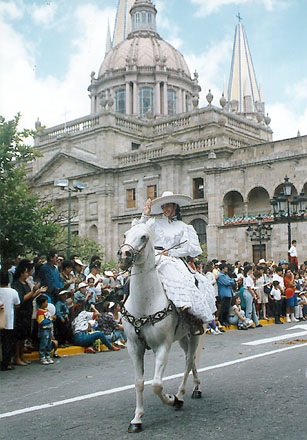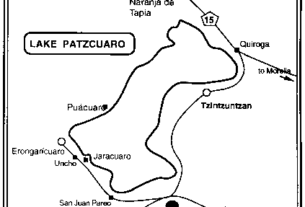At Home in Talpa de Allende, Jalisco

Wedding traditions vary all over the world and Mexico is no exception. Canada and the United States are such international melting pots that we may see Asian, African or English customs demonstrated in the same ceremony. The same is true in Mexico.
April and June have been designated as Bride’s Months in many countries. Add October as a favorite month in Mexico to “tie the knot.” I don’t know why October is so popular unless it is because the summer heat has abated, the harvesting is completed, and the bride’s family may have some extra pocket change.
I still think some of my northern friends have the right idea. It is much less expensive, although maybe not as romantic, to buy an aluminum ladder and lean it up against the house with the hopes your daughter will elope. A Mexican father might secretly go along with this idea, but the Mexican mother would probably balk. Mexican girls get to wear a long white dress and veil two times in their lives; First Communion and on their wedding day.
Childhood sweethearts
Joel and Margarita were childhood sweethearts through grammar school and preparatory, so it was no surprise to Mr. and Mrs. Chavez when Joel appeared at their house one day with hat in hand and his hair neatly combed, asking if he could come inside for some serious conversation. This may sound very old-fashioned to our modern youth, but it is still the custom in Mexico. Of course, this was not as impromptu as it looked. Margarita and Joel had planed this conversation for weeks. She had even tipped her parents off as to the day and hour Joel would arrive. She hid in the back room until Mr. and Mrs. Chavez asked the traditional questions, i.e., “How do you plan to support our daughter?” and “Where do you plan to live?” Having satisfied themselves they didn’t have much to object to regarding this proposed union, they gave their blessings and the wedding plans got underway.
Joel Sanchez is a rancher, the son of a rancher, the grandson of a rancher and a horseman to boot. Margarita’s father is a rancher and raises some fine horses also. It seemed only fitting they should plan a charro wedding.
Since Margarita was about twelve, her mother has been tutoring her for this new life. Besides knowing how to ride a horse and twirl a rope with her friends, she knew how to cook and sew. Although in many parts of the world it is considered to bring bad luck to the marriage if a bride makes her own wedding dress, it was decided Margarita would make hers.
It was a vision to behold the day the wedding took place. First, Joel – accompanied by his charro buddies, dressed elegantly in their tight fitting charro suits and with their horses meticulously groomed – paraded down the main street to the church on the plaza. They dismounted, tied their horses to a hitching post, and walked solemnly into the church to await the bride. In this case, the groom did not just have a best man; he had a best group of charro buddies.
Margarita came down the street next, in her fairytale wedding glory. She wore her wedding veil over a large white velvet sombrero. The dress she had made was a simple frock of white organdy with long sleeves and high neck, but the train was a cascade of ruffles completely covering the haunches of the horse and trailed down to its hooves. The horse seemed to know how to step slowly to the Wedding March being played over the loudspeakers from the church tower. Margarita didn’t ride alone. She was flanked by six attendants – all on horseback and magnificently dressed in yellow with matching sombreros.
Inside the church
The ceremony went as planned, complete with ‘kneeling pillows’ embroidered with Joel and Margarita’s name and the date of the wedding, on which they knelt while the priest blessed their union. The godparents had been selected for the lasso formed in a figure eight to go over the shoulders of the bride and groom, uniting them for life. Another set of godparents were in place to provide the thirteen gold coins signifying Jesus Christ and his twelve disciples and good fortune for the new married life of Joel and Margarita. The blue garter was in place, the penny was in the shoe, the dress was new and Margarita had borrowed a handkerchief from her grandmother, and then the dogs decided to attend the wedding ceremony.
Because they were obedient to their mistress, Margarita, they were not about to leave her side as she and Joel knelt at the altar. After a jolly romp through the plaza, their tongues hung out and spittle spraying the bride’s dress, the two dogs lay down by the kneeling couple. Cameramen were busy recording the dogs’ antics, and not those of the solemn vows being taken by the bride and groom. Neither the priest, Joel, Margarita or any of the godparents seemed to think this unusual. The official ceremony continued.
When the priest finally pronounced Joel and Margarita being husband and wife, there was not the usual lifting of the veil and the quick, but tender exchange of a kiss, but Margarita and Joel arose from their kneeling pillows and their godparents gave each of them an unlighted candle. They walked to the altar and lighted their candles from one that had been burning throughout the ceremony. With their lighted candles in hand, they walked to a table set to one side of the altar that held three unlighted candles lined up in a row. Joel lit one of the candles on the end, and turned and bowed to his family. Margarita followed by lighting the candle on the other end of the row, and turned and bowed to her family. With their backs to the forward facing pews, they both lighted the candle in the middle, blew out the candle they were holding and turned to face their families and friends. Now they were husband and wife.

